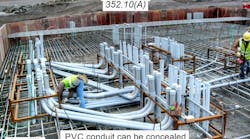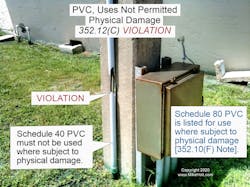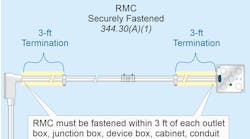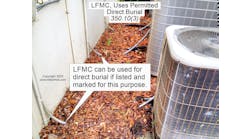Courtesy of www.MikeHolt.com
All questions and answers are based on the 2023 NEC.
Q: What are the conditions PVC can be used and installed?
(B) Corrosive Influences. PVC conduit is permitted in areas subject to severe corrosion for which the material is specifically approved by the authority having jurisdiction (AHJ).
(D) Wet Locations. PVC conduit is permitted in wet locations such as dairies, laundries, canneries, car washes, and other areas frequently washed. It is also permitted in outdoor locations. Support fittings such as straps, screws, and bolts must be made of corrosion-resistant materials or must be protected with a corrosion-resistant coating in accordance with Sec. 300.6(A).
(E) Dry and Damp Locations. PVC conduit is permitted in dry and damp locations except where limited in Sec. 352.12.
(F) Exposed. Schedule 40 PVC conduit is permitted for exposed locations where not subject to physical damage. If the conduit is exposed to physical damage, the raceway must be identified for the application.
Note: PVC Schedule 80 conduit is identified for use in areas subject to physical damage.
(G) Underground. PVC conduit is permitted to be installed underground and in concrete and must comply with the burial requirements of Sec. 300.5.
PVC conduit is not permitted in the following environments:
(A) Hazardous (Classified) Locations. PVC conduit is not permitted to be used in hazardous (classified) locations except as permitted by Sec. 501.10(A)(1)(a) Exception, Sec. 501.10(B)(6), Sec. 503.10(A), Sec. 504.20, Sec. 514.8 Exception No. 2, and Sec. 515.8.
(B) Support of Luminaires. PVC conduit is not permitted to be used for the support of luminaires or other equipment.
(C) Physical Damage. Type PVC conduit is not permitted to be installed where subject to physical damage unless identified for the application (see Fig. 2 below).
Author’s Comment: PVC Schedule 40 conduit is not identified for use where subject to physical damage, but PVC Schedule 80 conduit is [Sec. 352.10(F) Note].
(D) Ambient Temperature. PVC conduit is not permitted to be installed if the ambient temperature exceeds 50°C (122°F).
Author’s Comment: PVC conduit and fittings are not permitted to be installed in environmental air spaces (plenums) [Sec. 300.22(C)].
(A) Minimum. PVC conduit smaller than trade size ½ is not permitted to be used.
(B) Maximum. PVC conduit larger than trade size 6 is not permitted to be used.
These materials are provided by Mike Holt Enterprises in Leesburg, Fla. To view Code training materials offered by this company, visit www.mikeholt.com/code.







